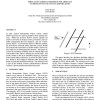Free Online Productivity Tools
i2Speak
i2Symbol
i2OCR
iTex2Img
iWeb2Print
iWeb2Shot
i2Type
iPdf2Split
iPdf2Merge
i2Bopomofo
i2Arabic
i2Style
i2Image
i2PDF
iLatex2Rtf
Sci2ools
WSC
2004
2004
Simulating Airspace Redesign for Arrivals to Detroit-Wayne County Airport (DTW)
In 2001, Detroit Metropolitan Wayne County Airport (DTW) opened a new runway parallel to three existing runways. While this increases DTW's runway capacity, the airport is served by an airspace (routes, procedures, and controller assignments) that was designed only for a threerunway airport. To increase the airport's effective capacity, the Detroit-area Terminal Radar Approach Control facility (D21 TRACON) and nearby Air Route Traffic Control Centers (ARTCC) are redesigning their airspace. This paper describes the simulation modeling effort to estimate delay and cost benefits of the ARTCC redesign for arrival traffic. The model, written in the SLX simulation language, represents miles-in-trail (MIT) restrictions, as well as air traffic controllers' ability to direct flights to different paths dynamically, based on predicted demand downstream. The redesign work is part of the Federal Aviation Administration's Midwest Airspace Capacity Enhancement (MACE) project.
Detroit Metropolitan Wayne County Airport | DTW's Runway Capacity | Modeling And Simulation | Terminal Radar Approach Control Facility | WSC 2004 |
| Added | 31 Oct 2010 |
| Updated | 31 Oct 2010 |
| Type | Conference |
| Year | 2004 |
| Where | WSC |
| Authors | Justin Boesel, David Bodoh |
Comments (0)

